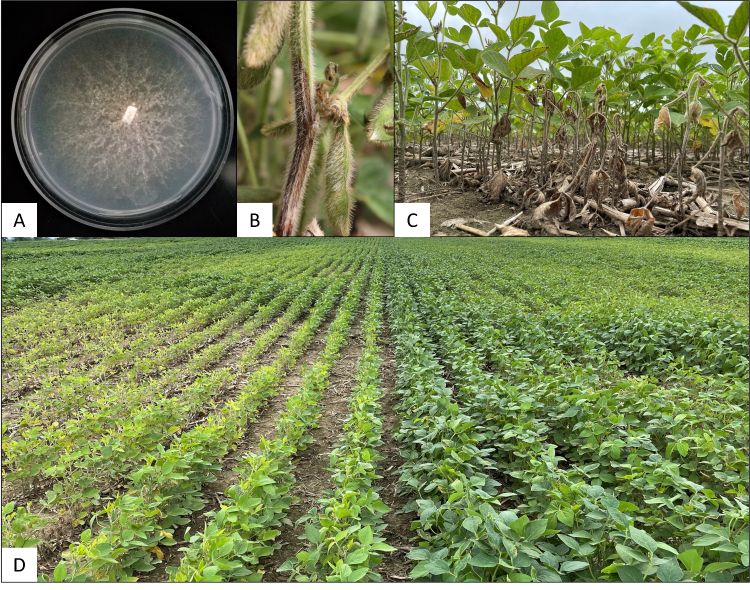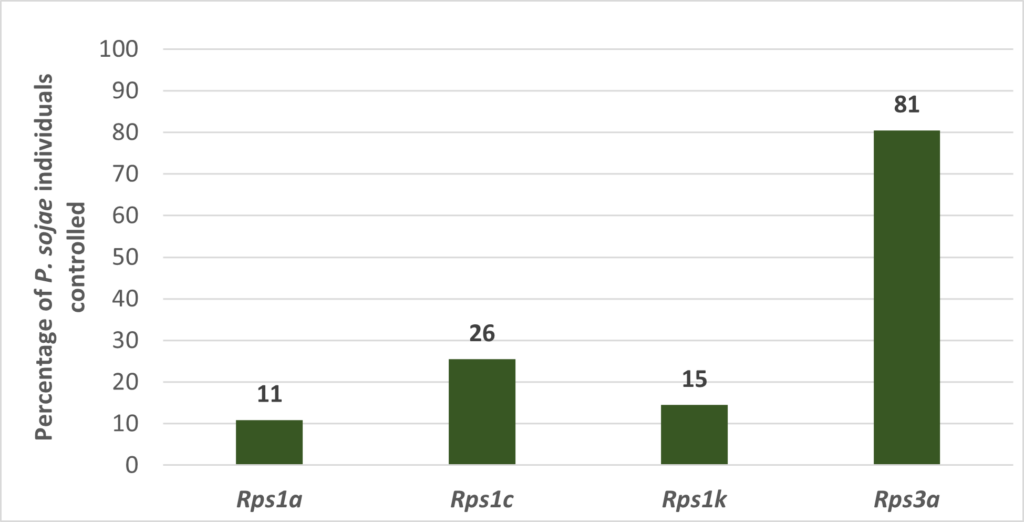Austin McCoy and Martin Chilvers, Michigan State University Department of Plant, Soil and Microbial Sciences; Eric Anderson and Mike Staton, Michigan State University Extension –
Managing soybean Phytophthora stem and root rot starts with variety resistance. A recent study led by MSU determined that previously relied upon resistance genes are failing and there is a need for soybean breeders to incorporate new sources of resistance.

Figure 1. Phytophthora sojae and Phytophthora root rot symptomatic plants at various scales. A: An isolate, or individual, of P. sojae. B: The diagnostic chocolate-brown stem lesion from Phytophthora root rot. C: A cluster of plants with Phytophthora root rot. D: Susceptible (left) and resistant (right) soybeans in a famers field. Photos by Austin McCoy and Martin Chilvers, MSU.
Takeaways
- Areas of the field with poor water drainage can lead to more severe Phytophthora stem and root rot disease.
- The most widely available Phytophthora stem and root rot resistance genes—Rps1a, Rps1c, Rps1k—currently only protect against 11%, 26% and 15% of P. sojae individuals in the United States.
- Rps3a currently protects against 81% of P. sojae individuals in the United States.
- P. sojae individuals can now cause disease on more resistance genes than they could 10 years ago, making management with Rps-genes more difficult.
- Best management for Phytophthora stem and root rot is to select varieties with an effective Rps-gene (Rps3a), moderate to high levels of partial resistance, and apply an effective seed treatment containing metalaxyl/mefenoxam, ethaboxam, oxathiapiprolin or picarbutrazox.
Phytophthora stem and root rot, caused by Phytophthora sojae, was prevalent across the United States soybean growing region last year. P. sojae is not a fungus but an oomycete, sometimes also called a water mold (Figure 1 panel A). Low-lying areas of fields with poor water drainage, such as compacted headlands, are the most prone to disease development. P. sojae can survive in resting structures for years in a field.
Upon soil saturation, the P. sojae resting structures can germinate to produce zoospores that will swim toward and infect soybean roots resulting in Phytophthora stem and root rot. Soybeans infected with Phytophthora stem and root rot will appear in clusters or as individual plants scattered throughout the field (Figure 1 panel C-D).
The disease can present a range of symptoms from stunting and wilting to the diagnostic chocolate brown stem lesion starting at the soil line and continuing up the stem of the plant at any growth stage (Figure 1 panel B). This brown stem lesion will eventually lead to the death of the plant in susceptible varieties.
Using resistant soybean varieties is one of the best disease management tools. There are two forms of resistance within soybean varieties: resistance genes to Phytophthora sojae (Rps) and partial resistance (referred to as field tolerance ratings in seed catalogues). In seed catalogues, soybean varieties known to contain Rps genes may be labelled as such, for example “contains Rps1c gene.” Effective Rps resistance genes confer complete protection from P. sojae populations that cannot overcome those genes. Partial resistance will not confer complete protection but will reduce yield loss and disease severity when under Phytophthora stem and root rot pressure. However, partial resistance may not be active until the first true leaves are formed, so seed treatments should be used to protect seedlings early in the season. Fungicide seed treatments containing metalaxyl, mefenoxam, ethaboxam, oxathiapiprolin or picarbutrazox can help reduce disease incidence a couple of weeks following planting but will not protect plants all season.
Best management practices for Phytophthora stem and root rot would be to select a soybean variety with an effective resistance gene and moderate to high levels of partial resistance, as well as applying a fungicidal seed treatment effective on P. sojae. Refer to “Fungicide Efficacy for Control of Soybean Seedling Diseases” from the Crop Protection Network when selecting an effective fungicide. Some seed treatments require a higher application rate to provide protection from Phytophthora stem and root rot, so communicate closely with your seed dealer. Improving field drainage and reducing soil compaction are also recommended.
In the United States, Canada and Argentina, the Rps resistance genes Rps1a, Rps1c and Rps1k are the most readily available for farmers to utilize. Rps3a is also increasingly available; however, it is not as common as Rps1a, Rps1cand Rps1k. Recent Phytophthora stem and root rot disease outbreaks and subsequent P. sojae surveys conducted by Extension pathologists question the current state of Rps gene efficacy in disease management. However, a worldwide analysis of Rps gene efficacy has not been conducted. Therefore, a global collaboration of plant pathologists led by Michigan State University was initiated to identify the current state of Rps gene efficacy on a national and global scale.
P. sojae survey work conducted by plant pathologists around the world from the last 30 years, representing Rps gene efficacy data on over 5,000 P. sojae individuals, was used for this study. We focused on the current efficacy of the Rpsgenes Rps1a, Rps1c, Rps1k and Rps3a as they are what farmers can currently utilize for disease management. We found that the most common resistance genes—Rps1a, Rps1c and Rps1k—are no longer widely effective in the United States, Canada and Argentina. As any given soybean field will contain a diverse population of P. sojaeindividuals capable of causing disease on plants with different Rps genes, it is important to utilize genes that control most individuals within a field. This study also shows that individuals of P. sojae are now able to cause disease on more resistance genes than they were 10 years ago.
In the United States, the majority of widely deployed Rps genes only control a fraction of the P. sojae individuals (Figure 2) with the genes Rps1a, Rps1c and Rps1k controlling 11%, 26% and 15% of P. sojae individuals, respectively. Only one Rps gene available to farmers for Phytophthora stem and root rot management was found to be widely effective: Rps3a, which controlled 81% of P. sojae individuals. In Michigan specifically, Rps1a, Rps1c andRps1k control 5%, 12% and 6% of P. sojae individuals, respectively, while Rps3a controls 69% of Michigan individuals.

Figure 2. Percentage of Phytophthora sojae individuals controlled by Rps genes in the United States.
In Michigan, soybean varieties including the Rps3a gene are available but only in a few varieties. An increase in availability of effective Rps genes, such as Rps3a, will be needed from companies to effectively manage Phytophthora stem and root rot in the future. In the meantime, farmers with fields that have a history of Phytophthora stem and root rot can utilize soybean varieties with the Rps3a gene and moderate to high levels of partial resistance in combination with an effective fungicide seed treatment to protect yields.
This article is based on research which is available at: A global-temporal analysis on Phytophthora sojae resistance-gene efficacy
This work was made possible by partial support from Michigan Soybean Committee, Project GREEEN, North Central Soybean Research Program and the United Soybean Board.


 and then
and then